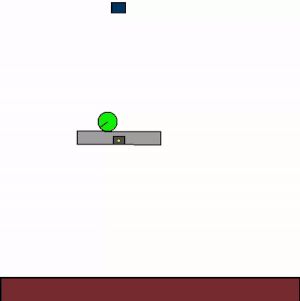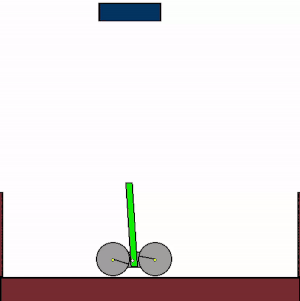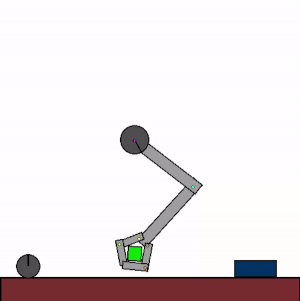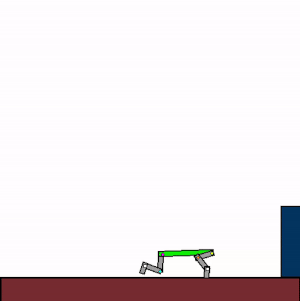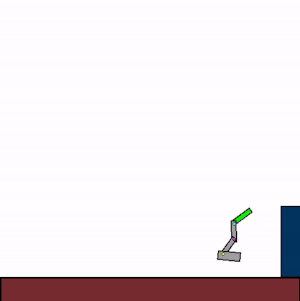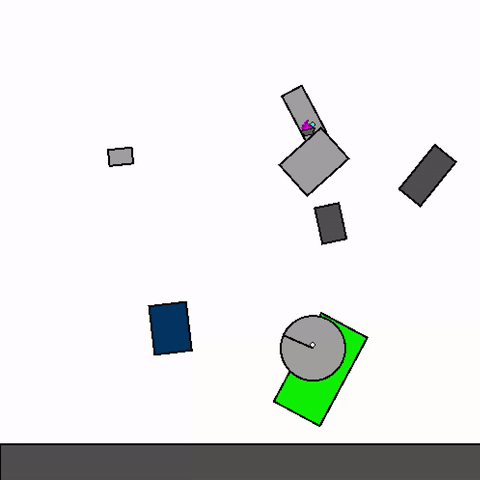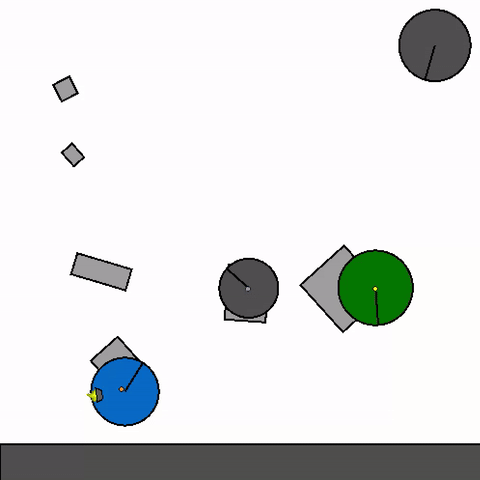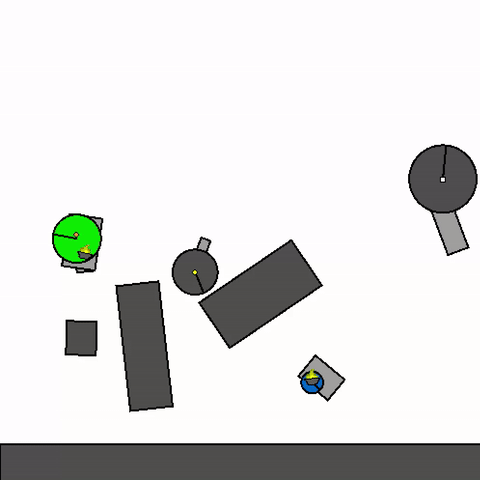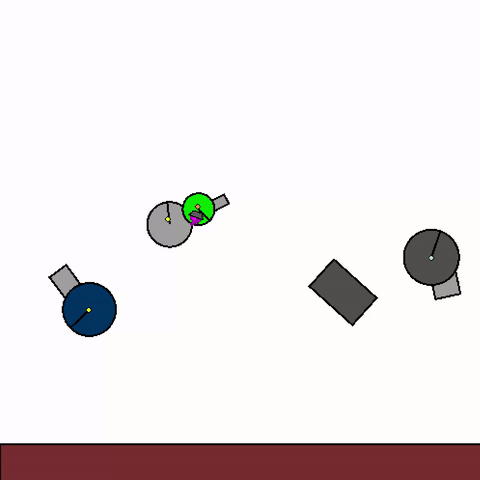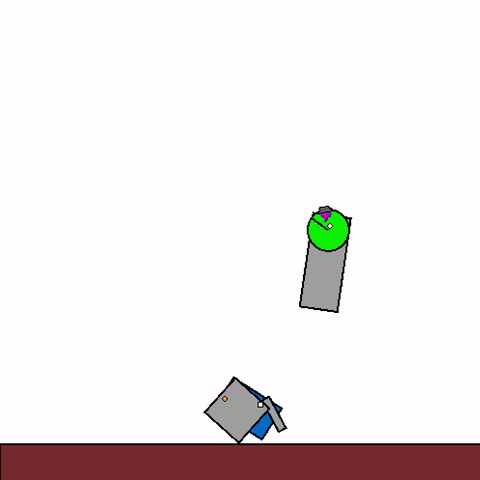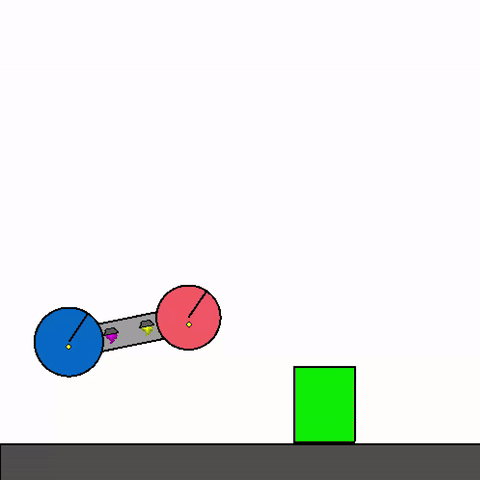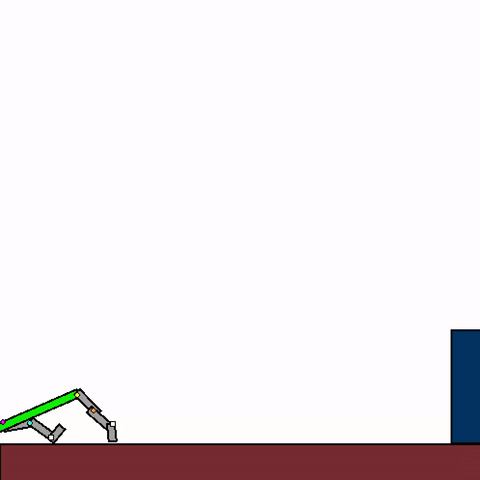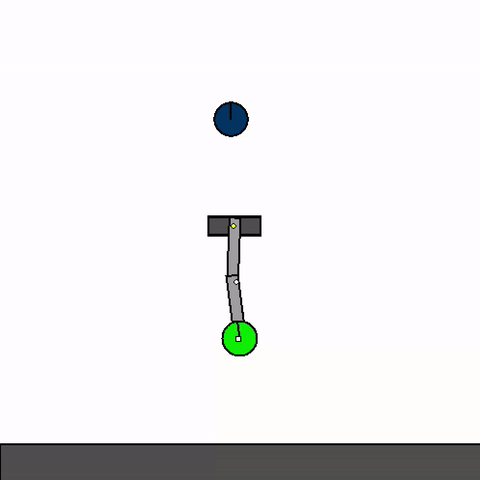Kinetix is a framework for reinforcement learning in a 2D rigid-body physics world, written entirely in JAX. Kinetix can represent a huge array of physics-based tasks within a unified framework. We use Kinetix to investigate the training of large, general reinforcement learning agents by procedurally generating millions of tasks for training. You can play with Kinetix in our online editor, or have a look at the JAX physics engine and graphics library we made for Kinetix. Finally, see our docs for more information and more in-depth examples.
The above shows specialist agents trained on their respective levels.
We train a general agent on millions of procedurally generated physics tasks. Every task has the same goal: make the green and blue touch, without green touching red. The agent can act through applying torque via motors and force via thrusters.
The above shows a general agent zero-shotting unseen randomly generated levels.
We then investigate the transfer capabilities of this agent to unseen handmade levels. We find that the agent can zero-shot simple physics problems, but still struggles with harder tasks.
The above shows a general agent zero-shotting unseen handmade levels.
Kinetix follows the interface established in gymnax:
# Use default parameters
env_params = EnvParams()
static_env_params = StaticEnvParams()
# Create the environment
env = make_kinetix_env(
observation_type=ObservationType.PIXELS,
action_type=ActionType.CONTINUOUS,
reset_fn=make_reset_fn_sample_kinetix_level(env_params, static_env_params),
env_params=env_params,
static_env_params=static_env_params,
)
# Reset the environment state (this resets to a random level)
_rngs = jax.random.split(jax.random.PRNGKey(0), 3)
obs, env_state = env.reset(_rngs[0], env_params)
# Take a step in the environment
action = env.action_space(env_params).sample(_rngs[1])
obs, env_state, reward, done, info = env.step(_rngs[2], env_state, action, env_params)
# Render environment
renderer = make_render_pixels(env_params, env.static_env_params)
pixels = renderer(env_state)
plt.imshow(pixels.astype(jnp.uint8).transpose(1, 0, 2)[::-1])
plt.show()To install Kinetix with a CUDA-enabled JAX backend (tested with python3.10):
git clone https://github.com/FlairOx/Kinetix.git
cd Kinetix
pip install -e ".[dev]"
pre-commit install
Tip
Setting export JAX_COMPILATION_CACHE_DIR="$HOME/.jax_cache" in your ~/.bashrc helps improve usability by caching the jax compiles.
Kinetix is also available on PyPi, and can be installed using pip install kinetix-env
We recommend using the KinetixJS editor, but also provide a native (less polished) Kinetix editor.
To open this editor run the following command.
python3 kinetix/editor.py
The controls in the editor are:
- Move between
editandplaymodes usingspacebar - In
editmode, the type of edit is shown by the icon at the top and is changed by scrolling the mouse wheel. For instance, by navigating to the rectangle editing function you can click to place a rectangle.- You can also press the number keys to cycle between modes.
- To open handmade levels press ctrl-O and navigate to the ones in the L folder.
- When playing a level use the arrow keys to control motors and the numeric keys (1, 2) to control thrusters.
We have three primary experiment files,
- SFL: Training on levels with high learnability, this is how we trained our best general agents.
- PLR PLR/DR/ACCEL in the JAXUED style.
- PPO Normal PPO in the PureJaxRL style.
To run experiments with default parameters run any of the following:
python3 experiments/sfl.py
python3 experiments/plr.py
python3 experiments/ppo.py
We use hydra for managing our configs. See the configs/ folder for all the hydra configs that will be used by default, or the docs.
If you want to run experiments with different configurations, you can either edit these configs or pass command line arguments as follows:
python3 experiments/sfl.py model.transformer_depth=8
These experiments use wandb for logging by default.
We provide several different ways to train RL agents, with the three most common options being, (a) Training an agent on random levels, (b) Training an agent on a single, hand-designed level or (c) Training an agent on a set of hand-designed levels.
Warning
Kinetix has three different environment sizes, s, m and l. When running any of the scripts, you have to set the env_size option accordingly, for instance, python3 experiments/ppo.py train_levels=random env_size=m would train on random m levels.
It will give an error if you try and load large levels into a small env size, for instance python3 experiments/ppo.py train_levels=m env_size=s would error.
This is the default option, but we give the explicit command for completeness
python3 experiments/ppo.py train_levels=random
Note
Check the kinetix/levels/ folder for handmade levels for each size category. By default, the loading functions require a relative path to the kinetix/levels/ directory
python3 experiments/ppo.py train_levels=s train_levels.train_levels_list='["s/h4_thrust_aim.json"]'
python3 experiments/ppo.py train_levels=s env_size=s eval=eval_auto
# python3 experiments/ppo.py train_levels=m env_size=m eval=eval_auto
# python3 experiments/ppo.py train_levels=l env_size=l eval=eval_auto
Or, on a custom set:
python3 experiments/ppo.py eval=eval_auto train_levels=l env_size=l train_levels.train_levels_list='["s/h2_one_wheel_car","l/h11_obstacle_avoidance"]'
- The left wall was erroneously misplaced 5cm to the left in all levels and all experiments in the paper (each level is a square with side lengths of 5 metres). This error has been fixed in the latest version of Jax2D, but we have pinned Kinetix to the old version for consistency and reproducability with the original paper. Further improvements have been made, so if you wish to reproduce the paper's results, please use kinetix version 0.1.0, which is tagged on github.
- 🌐 Kinetix.js Kinetix reimplemented in Javascript, with a live demo here.
- 🍎 Jax2D The physics engine we made for Kinetix.
- 👨💻 JaxGL The graphics library we made for Kinetix.
- 📋 Our Paper for more details and empirical results.
The permutation invariant MLP model that is now default was added by Anya Sims. Thanks to Thomas Foster for fixing some macOS specific issues. We'd also like to thank to Thomas Foster, Alex Goldie, Matthew Jackson, Sebastian Towers and Andrei Lupu for useful feedback.
If you use Kinetix in your work, please cite it as follows:
@article{matthews2024kinetix,
title={Kinetix: Investigating the Training of General Agents through Open-Ended Physics-Based Control Tasks},
author={Michael Matthews and Michael Beukman and Chris Lu and Jakob Foerster},
booktitle={The Thirteenth International Conference on Learning Representations},
year={2025},
url={https://arxiv.org/abs/2410.23208}
}








